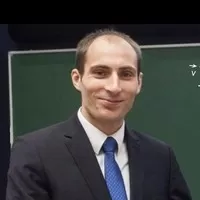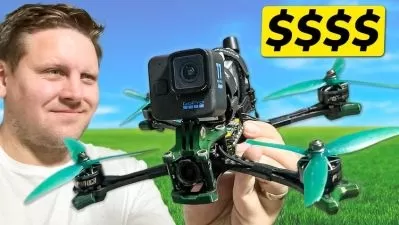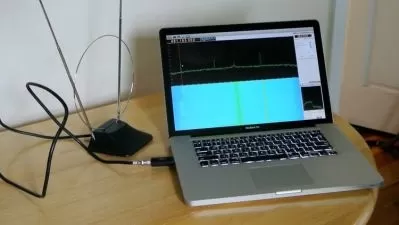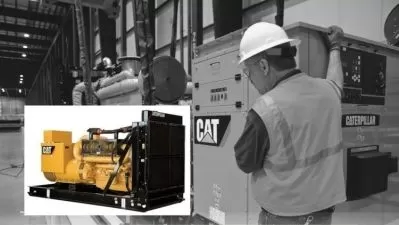Applied Control Systems 3: UAV drone (3D Dynamics & control)
Mark Misin Engineering Ltd
27:17:13
Description
Modeling + state space systems + Model Predictive Control + feedback control + Python simulation: UAV quadcopter drone
What You'll Learn?
- mathematical modelling of a UAV quadcopter drone
- obtaining kinematic equations: Rotation & Transfer matrices
- obtaining Newton-Euler 6 DOF dynamic equations of motion with rotating frames
- going from equations of motion to a UAV specific state-space equations
- understanding the gyroscopic effect & applying it to the UAV model
- understanding the Runge-Kutta integrator and applying it to the UAV model
- mastering & applying Model Predictive Control algorithm to the UAV
- mastering & applying a feedback linearization controller to the UAV
- combining Model Predictive Control and feedback linearization in one global controller
- simulating the drone's trajectory tracking in Python using the MPC and feedback linearization controller
Who is this for?
What You Need to Know?
More details
DescriptionOne of the greatest transformations that we will see in the next couple of decades is going to be the advent of autonomous drones. While being used extensively already, the applications of quadcopters will only grow in time. Drones will be used in delivery services, entertainment, medicine, military, rescue, structural quality inspection - places that people cannot reach easily, and in many other fields.
In many cases, there will be a predefined trajectory in a 3D space that the UAVÂ needs to follow without human help. In fact, humans might simply give a simple command for the drone to go somewhere, and then, a specific trajectory will be generated by a computer in that direction and the UAV's control algorithms will need to determine EXACTLY how fast each rotor should turn in order to make the drone follow that trajectory with high-degree precision.
And that's what this course is all about - its about DESIGNING, MASTERING, and APPLYINGÂ these control algorithms together with deriving the dynamics equations for the quadcopter.
In this course, you will receive a full package when it comes to learning about how to model and control a UAV drone and make it follow a trajectory in a 3D environment. Not only you will learn how to model a UAV system mathematically by deriving the equations of motion using the principles of 3D Dynamics, but you will also be exposed to some of the most powerful control techniques out there such as Model Predictive Control and feedback linearization.
In 3D dynamics, you will learn the fundamental math and physics behind the UAV quadcopter drone modelling. You will learn how to describe the position and orientation of a UAV quadcopter drone in a 3D space using rotation and transfer matrices, Newton - Euler 6 Degree of Freedom equations of motion, widely used Runge - Kutta integrator in engineering and propeller dynamics.
In the end of the course, I will also explain to you the code in the Python simulator.
Understanding the material in this course fundamentally, being able to quantify it mathematically, and knowing how to apply it using coding - that will give you an advantage in your engineering career that you cannot even imagine yet. It will give you a competitive edge that you need in the labor market.
I'm very excited to start working with you. Take a look at some of my free preview videos, and if you like what you see, then ENROLL in the course, and let's get started right now!
Who this course is for:
- Science and Engineering students
- Working Scientists and Engineers
- Control Engineering enthusiasts
One of the greatest transformations that we will see in the next couple of decades is going to be the advent of autonomous drones. While being used extensively already, the applications of quadcopters will only grow in time. Drones will be used in delivery services, entertainment, medicine, military, rescue, structural quality inspection - places that people cannot reach easily, and in many other fields.
In many cases, there will be a predefined trajectory in a 3D space that the UAVÂ needs to follow without human help. In fact, humans might simply give a simple command for the drone to go somewhere, and then, a specific trajectory will be generated by a computer in that direction and the UAV's control algorithms will need to determine EXACTLY how fast each rotor should turn in order to make the drone follow that trajectory with high-degree precision.
And that's what this course is all about - its about DESIGNING, MASTERING, and APPLYINGÂ these control algorithms together with deriving the dynamics equations for the quadcopter.
In this course, you will receive a full package when it comes to learning about how to model and control a UAV drone and make it follow a trajectory in a 3D environment. Not only you will learn how to model a UAV system mathematically by deriving the equations of motion using the principles of 3D Dynamics, but you will also be exposed to some of the most powerful control techniques out there such as Model Predictive Control and feedback linearization.
In 3D dynamics, you will learn the fundamental math and physics behind the UAV quadcopter drone modelling. You will learn how to describe the position and orientation of a UAV quadcopter drone in a 3D space using rotation and transfer matrices, Newton - Euler 6 Degree of Freedom equations of motion, widely used Runge - Kutta integrator in engineering and propeller dynamics.
In the end of the course, I will also explain to you the code in the Python simulator.
Understanding the material in this course fundamentally, being able to quantify it mathematically, and knowing how to apply it using coding - that will give you an advantage in your engineering career that you cannot even imagine yet. It will give you a competitive edge that you need in the labor market.
I'm very excited to start working with you. Take a look at some of my free preview videos, and if you like what you see, then ENROLL in the course, and let's get started right now!
Who this course is for:
- Science and Engineering students
- Working Scientists and Engineers
- Control Engineering enthusiasts
User Reviews
Rating
Mark Misin Engineering Ltd
Instructor's Courses
Udemy
View courses Udemy- language english
- Training sessions 235
- duration 27:17:13
- Release Date 2022/11/30

















